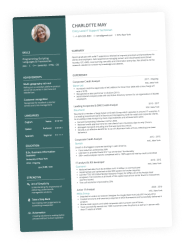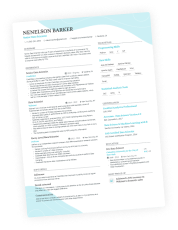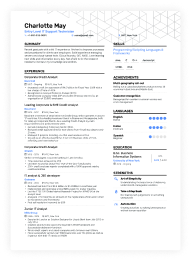A resume is more than a document—it’s your professional calling card. But while you may have the right experience and skills, small mistakes can prevent your application from even being considered. If you’ve ever asked yourself,Why does my resume keep getting rejected?, you’re not alone.
From generic layouts to missing keywords, these errors are surprisingly common but easily avoidable. The key is recognizing what holds you back and knowing how to fix it. In this guide, we’ll explore the ten most common reasons resumes are rejected and provide actionable strategies to turn your application into one that stands out.
Key takeaways
- Poor formatting and cluttered design make resumes hard to read and easy to reject.
- Customization is essential—generic resumes rarely make it past the first round.
- Keywords help you beat ATS filters and highlight relevant skills.
- Short, focused resumes are more effective than overly long documents.
- Employment gaps and red flags need a clear, honest context.
- Quantifiable achievements prove your impact better than vague statements.
- Typos, unprofessional emails, and missing key skills can instantly disqualify you.
Is your resume good enough?
Drop your resume here or choose a file. PDF & DOCX only. Max 2MB file size.
1. Poor formatting and design choices
The look of your resume often determines whether it gets a serious read. A cluttered resume layout, inconsistent fonts, or an overwhelming wall of text makes it difficult for recruiters to quickly find relevant information. When faced with hundreds of applications, they don’t have the time—or patience—to sift through messy formatting.
Why it matters
A poorly designed resume suggests a lack of attention to detail, which is a red flag in nearly every profession. Even strong experience can be overlooked if recruiters can’t easily navigate your document.
How to fix it
- Use clean, professional fonts like Rubik, Arial, Calibri, or Helvetica.
- Ensure headers and bullet points are consistent.
- Create a balance with white space so the document doesn’t feel overwhelming.
A resume crammed with long paragraphs about job duties is easy to skip.
Instead, use bullets like:
- Managed a sales team of 10, driving a 25% year-over-year revenue increase.
- Implemented a CRM system that reduced reporting time by 30%.
Once your resume looks professional, the next hurdle is ensuring it feels relevant. That brings us to customization.
2. Lack of customization
Recruiters can quickly spot a “one-size-fits-all” resume. Sending the same document to multiple employers signals that you haven’t taken the time to understand the hiring company’s specific needs.
Why it matters
A generic resume implies a lack of genuine interest in the role. Employers want to see that you’ve done your homework and understand how your skills align with their requirements.
How to fix it
- Tailor each resume to the job description.
- Emphasize skills and achievements that match the employer’s priorities.
- Use tools like Enhancv’s AI Resume Builder to streamline the customization process.
Example:
If a job posting highlights “experience with Agile methodologies,” your resume should explicitly mention “Agile project management” rather than a vague “managing projects.”
Of course, customizing your resume isn’t enough if it never makes it past automated screening software. That’s where keywords and ATS optimization come in.
3. Ignoring keywords and ATS optimization
Applicant tracking systems (ATS) are the digital gatekeepers of hiring. If your resume doesn’t include the right keywords, it may never reach a recruiter’s desk.
Why it matters
ATS software scans resumes for specific phrases from the job description. If you’re missing them, your document is filtered out before humans ever see it.
How to fix it
- Identify and use exact phrases from the job listing (e.g., “SEO strategies,” “project management”).
- Incorporate keywords naturally throughout your resume.
- Avoid keyword stuffing—it makes your document unreadable.
Example:
Instead of “improved company website,” write “developed SEO strategies that increased organic traffic by 40% in six months.”
Once your resume clears ATS, it still needs to keep a recruiter’s attention. Length and clarity become the next challenge.
4. Overly long or complex resumes
More isn’t always better. A resume that spans five pages or uses complicated formatting is overwhelming and likely to be rejected.
Why it matters
Recruiters don’t spend long scanning each resume. If yours is bloated with irrelevant jobs or dense paragraphs, key details will be missed.
How to fix it
- Limit your resume to one page if you’re early in your career—two pages if you have significant experience.
- Highlight only relevant roles and achievements.
- Break up text with bullets rather than paragraphs.
Example:
Instead of listing every summer job, focus on the last 10–15 years of experience, with measurable results for each role.
But even a concise, tailored resume can raise doubts if you leave employment gaps unexplained.
5. Unexplained employment gaps or red flags
Gaps in your resume often make recruiters wonder: Were you unemployed? Were you unreliable? Or were you simply not proactive in your career?
Why it matters
Hiring managers want stability and commitment. Unexplained gaps suggest the opposite
How to fix it
- Be transparent about time off, whether for education, freelancing, or personal reasons.
- Highlight constructive activities like certifications, volunteer work, or side projects.
- Reframe gaps as periods of growth, not absence.
Example:
“Took time to complete a Google Analytics certification and freelance for three small businesses, gaining advanced digital marketing skills.”
Transparency is important, but equally vital is showing measurable results from your career. That’s where quantifiable achievements come into play.
6. Lack of quantifiable achievements
Recruiters want proof of impact, not vague descriptions of responsibilities. “Managed a team” doesn’t carry as much weight as “Managed a team of 12 that increased annual sales by 25%.”
Why it matters
Numbers and metrics make your accomplishments concrete. They allow recruiters to see the value you could bring to their organization.
How to fix it
- Use percentages, dollar amounts, or timeframes to demonstrate results.
- Lead with strong action verbs.
- Think in terms of outcomes, not tasks.
Example:
“Implemented a new filing system that reduced processing time by 40% and saved $15,000 annually.”
Demonstrating achievements is crucial, but they won’t matter if your career objective is too vague or generic.
7. Vague job objectives and weak resume summaries
Objectives like “seeking a challenging position in a growing company” don’t tell recruiters anything meaningful. They waste prime real estate at the top of your resume without adding value.
Why it matters
Whether you use an objective or a resume summary, this section is often the first thing recruiters read. A vague or generic statement doesn’t differentiate you from other applicants. Employers want to know what you bring to the role, not just what you hope to gain from it.
How to fix it
- If you use an objective: Make it specific to the role and industry. Focus on how your skills align with the company’s goals.
- If you use a summary: Treat it as a highlight reel. Summarize your key achievements, years of experience, and unique strengths in three to four concise sentences.
- Avoid clichés: Phrases like “hardworking,” “team player,” or “results-oriented” don’t prove anything unless backed by examples.
Example (Objective):
“Seeking to apply five years of content marketing experience to help SaaS startups scale their brand visibility.”
Example (Summary):
“Marketing professional with five years of experience driving SEO strategies and content campaigns. Increased organic traffic by 40% for a SaaS startup while managing cross-functional teams to deliver measurable growth.”
Strong objectives and summaries give recruiters a clear picture of your intent and value. But they also expect to see proof of the right skill set throughout your resume. Missing skills can quickly sink your application.
8. Missing key skills
Omitting critical resume skills listed in the job description is a surefire way to get rejected.
Why it matters
Recruiters use skills as a quick filter to narrow down candidates. If yours aren’t there, you won’t make the shortlist.
How to fix it
- Identify both hard and soft skills from the job posting.
- Include them in a dedicated “Skills” section and in your work experience.
- Provide examples of how you used each skill.
Example:
Instead of “Proficient in Excel,” write, “Developed advanced Excel dashboards that reduced monthly reporting time by 20%.”
Even with the right skills, your application can fail instantly if riddled with errors.
9. Typos and grammatical errors
Nothing undermines professionalism faster than careless mistakes. A single typo may cause a recruiter to dismiss your application.
Why it matters
Errors suggest poor attention to detail and weak communication skills—both deal-breakers in most roles.
How to fix it
- Proofread carefully, multiple times.
- Use grammar tools like our free Resume Grammar Checker, but also get a peer review.
- Read your resume aloud to catch awkward phrasing.
Example:
A resume that says “mangaged” instead of “managed” signals sloppiness and can overshadow impressive achievements.
Lastly, even a flawless resume will fail if your contact details scream unprofessionalism.
10. Unprofessional contact information
Your contact information is the first thing recruiters see, and it sets the tone. An email address like “partyanimal123@gmail.com” immediately raises doubts about your seriousness as a candidate.
Why it matters
Sloppy contact details undermine credibility and can cost you an interview
How to fix it
- Use a professional email format, ideally firstname.lastname@email.com.
- Include your LinkedIn profile, not personal social media.
- Double-check that your phone number and email are current.
Example:
“alex.smith@email.com | linkedin.com/in/alexsmith” conveys credibility and professionalism.
What to do if your resume gets rejected
Even the strongest candidates face rejection. Instead of treating it as a failure, use it as a stepping stone.
- Request feedback (if possible): Politely ask the recruiter if they can share why you weren’t selected. Even a short response can highlight areas to improve.
- Review your resume again: Double-check resume formatting, keywords, and achievements. Did you tailor it enough for that specific job?
- Refine and reapply: Treat each rejection as a chance to sharpen your resume for the next opportunity.
- Expand your applications: Don’t rely on one role or company. Apply to a wider range of positions that align with your skills.
- Build your network: Sometimes referrals open more doors than cold applications. Connect on LinkedIn, attend events, and reach out to peers.
- Stay resilient: Rejection is part of the process, not a reflection of your potential. Many successful careers start with dozens of “no’s.”
Conclusion
Your resume is often your first impression—and small mistakes can make or break your chances. From poor formatting and missing keywords to unexplained gaps and unprofessional emails, each issue is fixable with the right approach.
By refining your layout, customizing it for every job, and focusing on measurable achievements, you transform your resume into a powerful tool that works for you.
PRO TIP
With Enhancv’s free AI Resume Builder, you can quickly create a resume that looks professional, highlights your strengths, and passes ATS filters with ease. Take control of your job search today and craft a resume that opens doors to your next opportunity.
Make one that's truly you.



